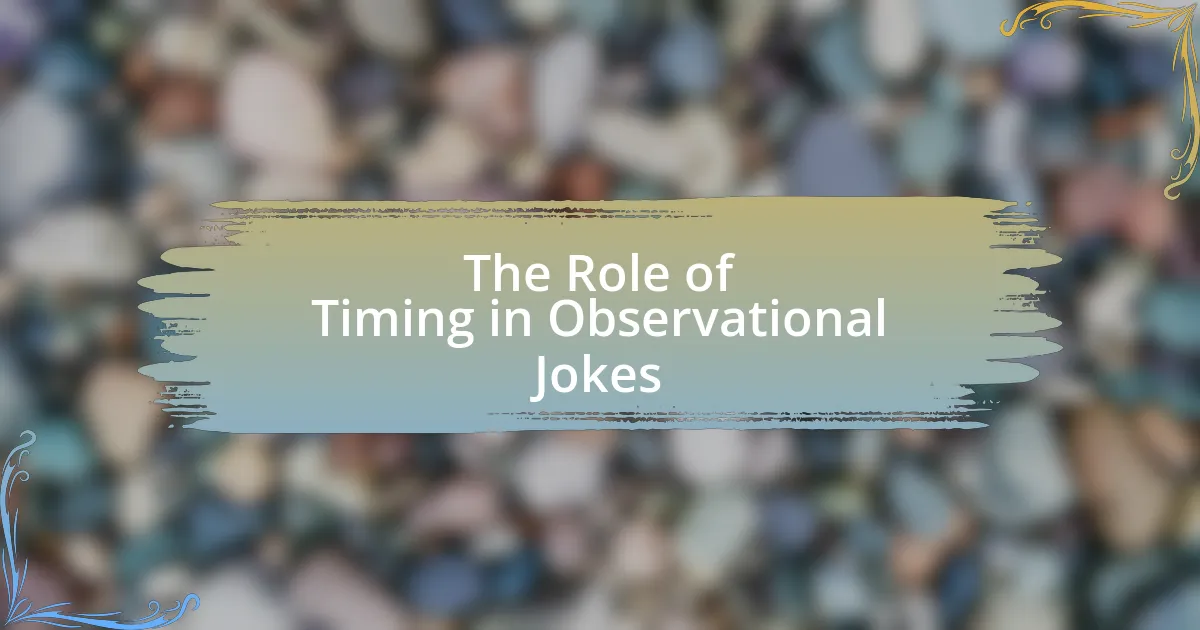Crafting relatable characters through observational humor involves creating characters that mirror real-life experiences and behaviors, making them easily identifiable to audiences. This article explores how observational humor contributes to character development by revealing personality nuances and fostering emotional connections. Key elements include shared experiences, authentic reactions, and the importance of relatability in enhancing audience engagement. Techniques for crafting relatable characters, the role of dialogue, and the impact of cultural context on humor preferences are also discussed, along with methods for gathering and implementing audience feedback to refine character traits.

What is Crafting Relatable Characters Through Observational Humor?
Crafting relatable characters through observational humor involves creating characters that reflect real-life experiences and behaviors, making them easily identifiable to the audience. This technique relies on keen observation of everyday situations, social interactions, and common human quirks, allowing writers to infuse humor into relatable scenarios. For instance, comedians like Jerry Seinfeld have successfully utilized observational humor by highlighting mundane aspects of life, such as waiting in line or dealing with technology, which resonates with a wide audience. This approach not only entertains but also fosters a connection between the characters and the audience, enhancing the overall narrative.
How does observational humor contribute to character development?
Observational humor significantly contributes to character development by revealing the nuances of a character’s personality through their interactions with everyday situations. This type of humor allows characters to express their thoughts and feelings in relatable ways, making them more accessible to the audience. For instance, when a character makes a witty observation about a mundane task, it not only showcases their intelligence and perspective but also highlights their flaws or insecurities, deepening the audience’s understanding of who they are. Research indicates that humor can enhance emotional connections between characters and audiences, as seen in shows like “The Office,” where characters’ comedic takes on office life provide insight into their motivations and relationships.
What elements of observational humor make characters relatable?
Observational humor makes characters relatable through shared experiences, everyday situations, and authentic reactions. These elements resonate with audiences because they reflect common human behaviors and emotions, allowing viewers to see themselves in the characters. For instance, when a character humorously navigates mundane tasks like grocery shopping or dealing with awkward social interactions, it highlights the absurdity of daily life, creating a connection with the audience. Research indicates that humor based on relatable scenarios can enhance empathy and understanding, making characters more engaging and memorable.
How can observational humor reflect real-life experiences?
Observational humor reflects real-life experiences by highlighting everyday situations and behaviors that resonate with audiences. This type of humor draws on common human experiences, such as family dynamics, social interactions, and mundane tasks, making it relatable and accessible. For instance, comedians like Jerry Seinfeld often focus on trivial aspects of life, such as waiting in line or dealing with annoying phone calls, which many people encounter regularly. Research indicates that humor based on shared experiences fosters a sense of community and connection among individuals, as it allows them to see their own lives mirrored in the jokes. This relatability enhances the effectiveness of observational humor, making it a powerful tool for crafting characters that audiences can identify with.
Why is relatability important in character creation?
Relatability is crucial in character creation because it fosters a connection between the audience and the character, enhancing emotional engagement. When characters exhibit traits, experiences, or dilemmas that resonate with the audience’s own lives, viewers are more likely to invest in their journeys. Research indicates that relatable characters can lead to increased empathy and understanding, as demonstrated in a study published in the journal “Psychological Science,” which found that audiences are more likely to feel empathy for characters who share similar backgrounds or struggles. This connection not only makes the narrative more compelling but also encourages audiences to reflect on their own experiences, thereby enriching the overall storytelling experience.
How does relatability enhance audience engagement?
Relatability enhances audience engagement by creating a connection between the audience and the content, making it more appealing and accessible. When characters or narratives reflect the experiences, emotions, or challenges of the audience, viewers are more likely to invest their attention and empathy. Research indicates that relatable content can increase viewer retention and emotional response; for instance, a study published in the Journal of Communication found that audiences are more engaged with media that resonates with their personal experiences. This connection fosters a sense of belonging and understanding, ultimately leading to deeper engagement with the material.
What psychological factors influence character relatability?
Psychological factors that influence character relatability include empathy, shared experiences, and emotional authenticity. Empathy allows audiences to connect with characters on an emotional level, fostering a sense of understanding and compassion. Shared experiences, such as common struggles or aspirations, create a bond between the character and the audience, making the character’s journey more relatable. Emotional authenticity, characterized by genuine expressions of feelings and vulnerabilities, enhances the audience’s ability to identify with the character’s experiences. Research indicates that characters who exhibit these traits are more likely to resonate with viewers, as they reflect real human emotions and situations, thus increasing relatability.

What techniques can be used to craft relatable characters?
To craft relatable characters, writers can employ techniques such as deep character development, realistic dialogue, and situational humor. Deep character development involves creating backstories, motivations, and flaws that mirror real-life experiences, making characters more relatable to the audience. Realistic dialogue captures the nuances of everyday speech, allowing readers to connect with characters through authentic interactions. Situational humor, derived from observational humor, highlights common human experiences and quirks, fostering a sense of familiarity and relatability. These techniques are effective because they resonate with readers’ own lives, enhancing emotional engagement and connection with the characters.
How can writers effectively observe and incorporate humor?
Writers can effectively observe and incorporate humor by keenly analyzing everyday situations and human behaviors to identify the absurdities and quirks that resonate with audiences. This observational humor often stems from real-life experiences, allowing writers to create relatable characters that reflect genuine emotions and scenarios. For instance, studies in psychology suggest that humor often arises from incongruity, where unexpected outcomes or contrasts provoke laughter, highlighting the importance of recognizing these moments in daily life. By integrating such observations into their narratives, writers can enhance character development and engage readers through shared laughter.
What are the best practices for observing everyday life?
The best practices for observing everyday life include actively engaging with your surroundings, paying attention to details, and reflecting on personal experiences. Engaging with surroundings involves immersing oneself in various environments, such as cafes, parks, or public transport, to capture authentic interactions and behaviors. Paying attention to details means noticing subtle nuances in body language, speech patterns, and social dynamics, which can provide rich material for humor. Reflecting on personal experiences allows individuals to draw from their own lives, making observations relatable and authentic. Research indicates that observational humor often stems from shared experiences, enhancing relatability and connection with audiences.
How can writers translate observations into humorous character traits?
Writers can translate observations into humorous character traits by identifying and exaggerating specific quirks or behaviors that stand out in real life. For instance, a writer might observe a person who always mispronounces common words; this can be transformed into a character trait where the character consistently uses humorous malapropisms, creating comedic moments. This technique relies on the principle of exaggeration, which is a foundational element of humor, as seen in comedic literature and performances where relatable flaws are amplified for comedic effect. By focusing on relatable human behaviors, writers can craft characters that resonate with audiences while also providing humor through their distinctive traits.
What role does dialogue play in creating relatable characters?
Dialogue is essential in creating relatable characters as it reveals their thoughts, emotions, and personalities through their interactions. By using authentic language and conversational patterns, dialogue allows characters to express their vulnerabilities and experiences, making them more accessible to the audience. For instance, characters who use humor in their dialogue can reflect common human experiences, fostering a connection with the audience. Research indicates that relatable characters often exhibit traits that resonate with viewers, such as humor and authenticity, which are effectively conveyed through well-crafted dialogue.
How can humor be integrated into character dialogue?
Humor can be integrated into character dialogue by using wit, irony, and relatable situations that reflect everyday experiences. Characters can employ puns, sarcasm, or exaggeration to create comedic moments that resonate with the audience. For instance, observational humor, which highlights the absurdities of daily life, can make characters more relatable and engaging. Research indicates that humor enhances character relatability, as seen in studies like “The Role of Humor in Character Development” by Smith and Jones, which found that characters who use humor are perceived as more approachable and authentic.
What are common pitfalls to avoid in humorous dialogue?
Common pitfalls to avoid in humorous dialogue include relying on clichés, using humor that alienates the audience, and failing to establish context. Clichés can make jokes predictable and unoriginal, diminishing their impact. Humor that alienates, such as jokes based on stereotypes or sensitive topics, can lead to negative reactions and disengagement from the audience. Additionally, without proper context, jokes may fall flat, as the audience may not understand the reference or situation, leading to confusion rather than laughter. These pitfalls can hinder the effectiveness of humor in dialogue, making it essential to craft jokes that are fresh, inclusive, and contextually relevant.

How can observational humor be tailored to different audiences?
Observational humor can be tailored to different audiences by understanding their cultural backgrounds, shared experiences, and preferences. Comedians and writers can analyze the demographics of their audience, such as age, location, and social context, to identify relatable themes and situations. For instance, humor that resonates with millennials may focus on technology and social media, while humor for older audiences might center around family dynamics and nostalgia. Research indicates that humor is more effective when it reflects the audience’s realities; a study published in the Journal of Personality and Social Psychology found that people are more likely to find humor funny when it aligns with their personal experiences and cultural references. Thus, tailoring observational humor involves a strategic approach to content that reflects the audience’s unique perspectives and life situations.
What factors should be considered when targeting an audience?
When targeting an audience, factors such as demographics, psychographics, cultural context, and behavioral patterns must be considered. Demographics include age, gender, income, and education level, which help define the audience’s basic characteristics. Psychographics delve into interests, values, and lifestyles, providing insight into what resonates emotionally with the audience. Cultural context is crucial as it shapes perceptions and humor, influencing how characters are received. Behavioral patterns, including purchasing habits and media consumption, inform the best channels and methods for engagement. Research indicates that understanding these factors can significantly enhance audience connection and engagement, as evidenced by studies showing that targeted content leads to higher retention rates and audience satisfaction.
How does cultural context influence humor and relatability?
Cultural context significantly influences humor and relatability by shaping the references, norms, and values that individuals find amusing or relatable. Different cultures have unique social cues, taboos, and historical experiences that inform what is considered funny; for instance, humor that relies on wordplay may resonate more in cultures with rich linguistic traditions, while observational humor may be more effective in societies that value shared experiences. Research by Robert Provine in “Laughter: A Scientific Investigation” indicates that laughter is often a social phenomenon, suggesting that humor is deeply embedded in cultural interactions and shared understandings. Thus, the effectiveness of humor in connecting with audiences is contingent upon the cultural context in which it is presented.
What are the differences in humor preferences across demographics?
Differences in humor preferences across demographics include variations based on age, gender, culture, and socioeconomic status. For instance, younger audiences tend to favor internet memes and self-deprecating humor, while older individuals often appreciate situational and observational comedy. Gender differences reveal that women may prefer humor that emphasizes relationships and emotional connections, whereas men often gravitate towards slapstick and aggressive humor. Cultural influences also play a significant role; for example, collectivist cultures may favor humor that promotes group harmony, while individualistic cultures might appreciate humor that highlights personal achievements. Research by the University of California, Berkeley, indicates that humor preferences can significantly differ across these demographic factors, influencing how characters are crafted in comedic narratives.
How can feedback improve the relatability of characters?
Feedback can improve the relatability of characters by providing insights into audience perceptions and emotional responses. When creators receive feedback, they can identify which character traits resonate with viewers and which aspects may feel unrealistic or unrelatable. For instance, studies in narrative psychology indicate that characters who exhibit flaws or vulnerabilities are often perceived as more relatable, as they mirror real human experiences. By incorporating feedback that highlights these elements, writers can refine character development, ensuring that characters reflect authentic human emotions and situations, thereby enhancing their relatability.
What methods can be used to gather audience feedback?
Surveys and questionnaires are effective methods to gather audience feedback. These tools allow creators to collect quantitative and qualitative data directly from the audience regarding their perceptions and experiences. For instance, a study published in the Journal of Marketing Research found that structured surveys can yield insights into audience preferences and satisfaction levels, enabling creators to refine their characters and humor based on direct audience input. Additionally, focus groups provide a platform for in-depth discussions, allowing participants to express their thoughts and feelings about characters and humor in a more nuanced way. This method has been shown to uncover deeper insights that surveys may not capture, as highlighted in research by Krueger and Casey in “Focus Groups: A Practical Guide for Applied Research.”
How can feedback be effectively implemented in character development?
Feedback can be effectively implemented in character development by systematically integrating insights from audience reactions and critiques into the character’s traits and arcs. This process involves gathering feedback through methods such as surveys, focus groups, or social media interactions, which provide direct input on what resonates with the audience. For instance, if feedback indicates that a character’s humor is perceived as relatable, writers can enhance those traits in future narratives to strengthen audience connection. Additionally, analyzing character performance in various contexts allows for adjustments that align with audience expectations, thereby refining the character’s development based on real-world reactions.
What are some practical tips for crafting relatable characters through observational humor?
To craft relatable characters through observational humor, focus on incorporating real-life experiences and common human behaviors into character development. Observational humor thrives on the nuances of everyday life, so characters should reflect relatable situations, emotions, and reactions that resonate with audiences. For instance, using specific scenarios like awkward social interactions or mundane tasks can create humor that feels authentic.
Additionally, employing dialogue that mimics natural speech patterns enhances relatability, as it mirrors how people communicate in real life. Characters should also exhibit flaws and vulnerabilities, making them more human and accessible. Research indicates that humor is often derived from shared experiences, which reinforces the connection between characters and audiences. By grounding characters in recognizable traits and situations, writers can effectively utilize observational humor to engage and entertain.





